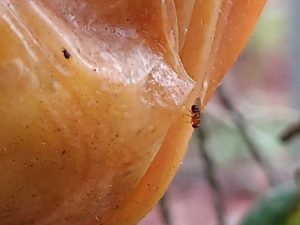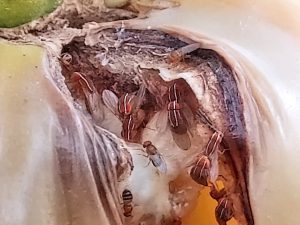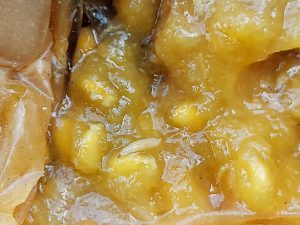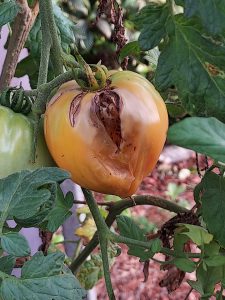If you have seen flies flying around your ripe fruits, it is probably a fruit fly. Drosophila (a genus of flies that includes the family Drosophilidae), also known as small fruit flies, are a common pest in Florida all-year-round. Especially during late summer/fall. They can be found almost everywhere, including houses, restaurants, markets, farms, etc.

How do I know these are fruit flies?
There are approximately 1,500 different species of Drosophila, each with their own distinct characteristics. Florida is home to approximately 27 species of fruit flies. It is important to remember that for proper identification of a specific species, an expert in the subject matter may be needed. In general, the common fruit fly (Drosophila melanogaster) has red eyes, are yellow-brown in color, adults are approximately 0.1 inches long, and have black rings in their abdomen. Females have a pointier and longer abdomen, and the male’s abdomen are darker at the end.
Why I have these unwanted pests here?
Drosophila are attracted to ripened, fermenting, or rotten fruit and vegetables. Fruit fly infestations occur indoors when fruit and vegetables are brought inside a building, especially when they are ripe or fermenting. In farms, when fruits are ripe, these flies will be attracted to them causing damage to the produce. This means that harvesting timing is important to avoid infestations at farms and other agricultural establishment. Another attractant to Drosophila could be any other rotten/fermenting materials on the farms besides fruits. They are commonly found in garbage disposals, trash containers, empty cans/bottles, and surfaces that are moist containing fermenting materials.

How long it takes for the flies to infest fruits?
Fruit flies display complete metamorphosis, meaning they have 4 stages in their life cycle, egg, larva, pupa, and adult. Fruit flies can complete their developing cycle in approximately one week if environmental conditions are favorable (moist environment with a food source). After mating the eggs are laid in approximately 24hrs on fruits and vegetables. The eggs (Drosophila melanogaster) are white and oval shaped, and they will hatch in the fruit they are laid on. Once hatched, the white larva start eating the fruit. It goes through 3 instars stages, and in 4 days it morphs into a pupa. The pupa stage lasts for 4 days, until the adult emerges from it. The adult life span of a fruit fly is between 40 to 50 days. Adult females can lay up to 500 eggs during its lifetime.

How can they damage my fruits and vegetables?
Although most fruit flies are associated with ripened or fermented fruits, Drosophila suzukii (spotted wing Drosophila) can infest un-ripened fruits and are of economic importance to agriculture. Economic losses are caused because of maggots infesting the fruits making the produce unsuitable for consumption, or by holes created by the females when they lay eggs, which allow bacteria or fungus to enter and colonize the fruits. This can cause substantial loss of produce depending on the size of the infestation.
How do I get rid of these pests?
Prevention and Sanitation: The easiest way to prevent fruit fly infestations is to eliminate any attractant of the flies. Remove any fermented or rotten fruits and vegetables from your house, garden, or farm. If you want fruits to ripen on the plants, harvest the fruits as soon as they are ready to avoid possible infestations. Clean any surface that may contain pieces of fermented or rotten fruit and remove any debris that may accumulate moisture and fruit residues.

Monitoring and mechanical control: It is always a good practice to monitor fruit fly populations. You can create a trap by using a container with 32 oz of yeast-sugar-water. The flies will be attracted to this container and drown in it. Later you can count how many flies have died in this container, and with this you can calculate the size of the infestation. Depending on the size of the population you can determine if further control will be necessary. Another method similar is to use sticky traps, which basically do the same function as the yeast-sugar-water traps.
Biological control: Fruit flies also have many natural predators like small reptiles, birds, spiders, and certain insects such as beetles and ants. Depending on your situation, allowing certain naturals enemies to help control fruit fly populations may be effective in combination with other control practices.
Chemical control: Finally, there are numerous pesticides that can control fruit flies such as Pyrethrin, Spinosad, and other insecticides. When using pesticides always follow the label instructions to verify on what plants the pesticide can be used, and to check harvest intervals.

Conclusion
Fruit flies are a common pest that can infest, relatively quickly, farm crops because of their fast life cycle. To avoid possible economic losses, it is important to remove the sources that attract these pests into an area such as fermenting or rotting fruits and ripped unharvest fruits. Always monitor pest populations to make the best decision when controlling these pests.
If you want more information on this topic or similar topics, please contact your local UF/IFAS Extension Agent.
University of Florida is an Equal Opportunity Institution.
 0
0
